
Overview
Since 2005, the number of those immigrating to the Netherlands has continued to climb in part due to the rise of globalization, free movement throughout the European Union, and a strengthening Dutch economy. In 2018, according to the CBS (The Dutch Central Bureau for Statistics) approximately 69.500 more people from abroad registered with a municipality in the Netherlands compared to the number of those who left the country. (See graphs below on migration)
Overview
Since 2005, the number of those immigrating to the Netherlands has continued to climb in part due to the rise of globalization, free movement throughout the European Union, and a strengthening Dutch economy.
In 2018, according to the CBS (The Dutch Central Bureau for Statistics) approximately 69.500 more people from abroad registered with a municipality in the Netherlands compared to the number of those who left the country. (See graphs below on migration)
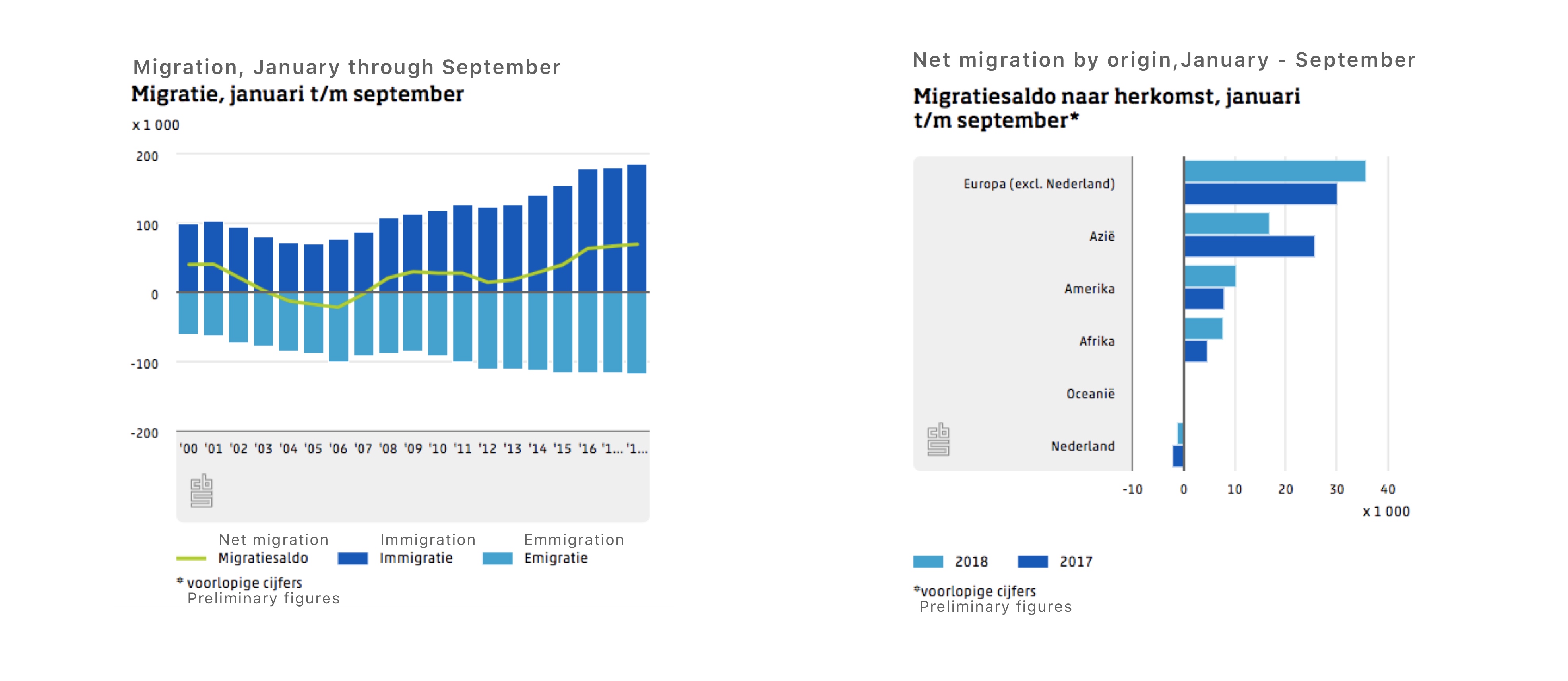
Image Source: Centraal Bureau voor de Statistiek. (2018, October 29). Aantal immigranten en emigranten ook in 2018 hoog. Retrieved April 18, 2019, from https://www.cbs.nl/nl-nl/nieuws/2018/44/aantal-immigranten-en-emigranten-ook-in-2018-hoog
Image Source: Centraal Bureau voor de Statistiek. (2018, October 29). Aantal immigranten en emigranten ook in 2018 hoog. Retrieved April 18, 2019, from https://www.cbs.nl/nl-nl/nieuws/2018/44/aantal-immigranten-en-emigranten-ook-in-2018-hoog
With this data in mind, an often asked question by people is “How can I move to the Netherlands?”
But, largely it's not always clear as to how to actualize this plan. Moreover, it is also difficult to know what the guidelines and constraints may be to immigrate. Immigrating to a new country is a complex situation, but navigating through the bureaucratic requirements of the immigration process can be an even more daunting experience.
The Dutch Immigration Service (IND - Immigratie en Naturalisatie Dienst) outlines necessary information on their website as to how to legally move and establish residency in the Netherlands. But, as is often the case with legal and policy-based information, it’s not designed with optimizing user experience in mind.
"Immi" is created to serve as an "immigration assistent" mobile and web-based tool. The goal of immi is to help users bridge the gap between wanting to move abroad and making it a reality by successfully applying for a visa. Immi assists in determining personal eligibility for entry, visa application options, and helps users complete their application.
Ideally, the goal of immi is to expand its capabilities to offer immigration assistance for people of all nationalities in any part of the world. In this, people would be able to digitally navigate country-specific immigration requirements behind any web or mobile device. But, this ambition is definitely beyond the scope of this current project.
With this data in mind, an often asked question by people is “How can I move to the Netherlands?”
But, largely it's not always clear as to how to actualize this plan. Moreover, it is also difficult to know what the guidelines and constraints may be to immigrate.
Immigrating to a new country is a complex situation, but navigating through the bureaucratic requirements of the immigration process can be an even more daunting experience.
The Dutch Immigration Service (IND - Immigratie en Naturalisatie Dienst) outlines necessary information on their website as to how to legally move and establish residency in the Netherlands. But, as is often the case with legal and policy-based information, it’s not designed with optimizing user experience in mind.
"Immi" is created to serve as an "immigration assistent" app and web-based tool. The goal of immi is to help users bridge the gap between wanting to move abroad and making it a reality by successfully applying for a visa. Immi assists in determining personal eligibility for entry, visa application options, and helps to complete the application process.
Ideally, the goal of immi is to expand its capabilities to offer immigration assistance for people of all nationalities in any part of the world. In this, people would be able to digitally navigate country-specific immigration requirements behind any web or mobile device. But, this ambition is definitely beyond the scope of this current project.
The Problem
Information on how to legally immigrate to another country should be accessible to everyone. It should not only be limited to people who have the educational privledge of being able to make sense of legal jargon. It should also not be exclusive to people who are financially well-off enough to hire a lawyer to help them complete and file their application.
The IND website provides a good starting point for users to find the surface information they may be looking for, but user experience takes a back seat. The burden is heavily placed on the user to make sense of navigating the website, the application process, costs, and requirements. Information is, in certain cases, only available in Dutch, such as available guidance when applying for a residence permit for your spouse, partner, or child.
The Problem
Information on how to legally immigrate to another country should be accessible to everyone. It should not only be limited to people who have the educational privledge of being able to make sense of legal jargon. It should also not be exclusive to people who are financially well-off enough to hire a lawyer to help them complete and file their application.
The IND website provides a good starting point for users to find the surface information they may be looking for, but user experience takes a back seat. The burden is heavily placed on the user to make sense of navigating the website, the application process, costs, and requirements. Information is, in certain cases, only available in Dutch, such as available guidance when applying for a residence permit for your spouse, partner, or child.

Process

Identify and Understand
The main goals of this project are to:
- Help users (potential visa applicants) more efficiently find the information they need related to immigration
- Create a more personalized system that allows users to know their status as to if they are able to apply for a visa
- Guide users through the process of preparing necessary documents and applying
- Achieve above results through the design of a modern, interactive, and user-friendly prototype
Secondary goals include:
- Potentially offering continued guidance after visa approval is granted (i.e., Government registration, housing, etc.)
- Making users aware of additional resources such as healthcare, insurance, etc.
Identify and Understand
The main goals of this project are to:
- Help users (potential visa applicants) more efficiently find the information they need related to immigration
- Create a more personalized system that allows users to know their status as to if they are able to apply for a visa
- Guide users through the process of preparing necessary documents and applying
- Achieve above results through the design of a modern, interactive, and user-friendly prototype
Secondary goals include:
- Potentially offering continued guidance after visa approval is granted (i.e., Government registration, housing, etc.)
- Making users aware of additional resources such as healthcare, insurance, etc.
Research
The first step of the research process was to identify the specific shortcomings of the IND website related to (1) users being able find information about immigration, (2) making users aware as to if they are eligible to apply, and (3) guiding users through the application process.
The second step was to translate available information into a flow diagram of questions and answers that would underlie the "Immigration Assistant" program.
On the IND website, some of the main issues included the following:
Issue 1
The site attempts to clarify information for users by use of lengthly, dense paragraphs of answers. These answers are also written in a very small font size. This information is presented in application forms and brochures which users have to read through and dissect to find complete answers related to their situation.
Research
The first step of the research process was to identify the specific shortcomings of the IND website related to (1) users being able find information about immigration, (2) making users aware as to if they are eligible to apply, and (3) guiding users through the application process.
The second step was to translate available information into a kind of "decision tree" pathway of questions and answers that would underlie the "Immigration Assistant" program.
On the IND website, some of the main issues included the following:
Issue 1
The site attempts to clarify information for users by use of lengthly, dense paragraphs of answers. These answers are also written in a very small font size. This information is presented in application forms and brochures which users have to read through and dissect to find complete answers related to their situation.
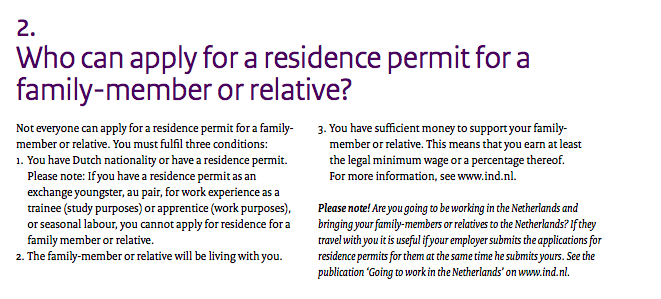
Issue 2
There is no apparent hierarchy to the requirements presented for applicants. Although a requirement "checklist" (which serves more as a bulleted list than a checklist, as it's not personalized or interactive) is provided, the items are not organized in any way in terms or priority, importance, or sequence of events in which responsibilities must be completed.
For example, in order for a foreign applicant to come live with their Dutch spouse in the Netherlands, their Dutch spouse must have "independent, sufficient, and sustainable income." This requirement is much more critical and requires greater long-term planning and preparation than the guideline than "You and your partner are going to live together." Yet the sufficient, long term income requirement is at the very bottom of the list.
Issue 2
There is no apparent hierarchy to the requirements presented for applicants. Although a requirement "checklist" (which serves more as a bulleted list than a checklist, as it's not personalized or interactive) is provided, the items are not organized in any way in terms or priority, importance, or sequence of events in which responsibilities must be completed.
For example, in order for a foreign applicant to come live with their Dutch spouse in the Netherlands, their Dutch spouse must have "independent, sufficient, and sustainable income." This requirement is much more critical and requires greater long-term planning and preparation than the guideline than "You and your partner are going to live together." Yet the sufficient, long term income requirement is at the bottom of the list.

Issue 3
In the process of completing an application form, users must sort through an extensive amount of information and choices to select the conditions by which a situation applies to them. For example, the application for the purpose of residence for sponsorship by a family member has an overwhelming amount of text. It is not a simple process to "Please tick the applicable sutuation and follow the instructions" when the information is presented in an overwhelming manner for users.
Issue 3
In the process of completing an application form, users must sort through an extensive amount of information and choices to select the conditions by which a situation applies to them. For example, the application for the purpose of residence for sponsorship by a family member has an overwhelming amount of text. It is not a simple process to "Please tick the applicable sutuation and follow the instructions" when the information is presented in an overwhelming manner for users.
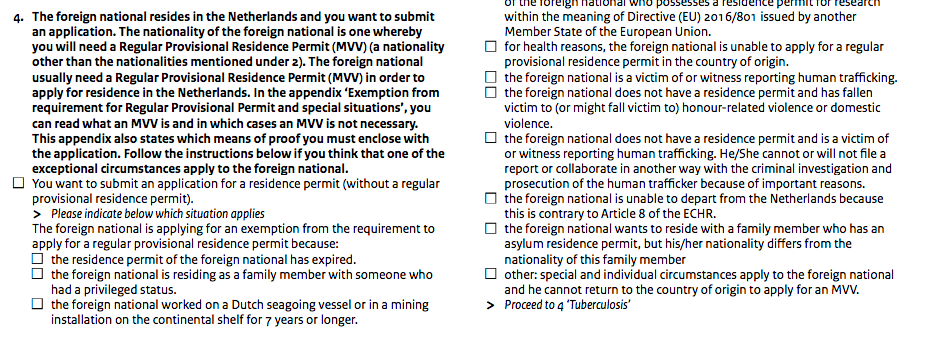
Reflect
In meeting the main goals of ensuring:
- efficiency
- personalization
- effective guidance
- user-friendly design
The design of immi intends on using questions with (mainly binary) answers which will be coded and archived to create an applicant profile during use. Unlike a traditional form which can be somewhat sterile and impersonal, typical form-based questions and fields will be translated into "friendly" prompts with a human touch.
On the surface, immi appears to be a helpful, interactive tool. But at its core, it's really just an alternative means of filling in a form by use of a strategic, user-friendly design that comes to life with programming.
Analyze
The aim of immi as a system is to present personalized questions that steer users in the right direction based on their immigration situation. Immi will rely on an enumeration to store a user's answers and archive them as the user continues to progress through use of the tool. Questions displayed will follow a corresponding sequence aligned with user's prior answers.
Sometimes the motive of the questions will not be as obvious to the user, but the answer to the questions will determine key factors like eligibility to apply for a visa. For example, an underlying question is "Do you have EU/EAA nationality? [Yes, or No]" But this question feels somewhat exclusionary and interrogative.
Instead, the questions that the user will see are: "Where do you want to move?" and "What passport, or passports, do you have?" This followed by a list where users can type or select their relevant passport(s). This question feels more open and optimistic, than as if you're being interrogated.
Reflect
In meeting the main goals of ensuring:
- efficiency
- personalization
- effective guidance
- user-friendly design
The design of immi intends on using questions with (mainly binary) answers which will be coded and archived to create an applicant profile during use. Unlike a traditional form which can be somewhat sterile and impersonal, typical form-based questions and fields will be translated into "friendly" prompts with a human touch.
Sometimes the motive of the questions will not be as obvious to the user, but the answer to the questions will determine key factors like eligibility to apply for a visa. For example, an underlying question is "Do you have EU/EAA nationality? [Yes, or No]" But this question feels somewhat exclusionary and interrogative.
Instead, the questions that the user will see are: "Where do you want to move?" and "What passport, or passports, do you have?" This followed by a menu where users can type or select their relevant passport(s). This question feels more open for and optimistic, than as if you're being interrogated.
Potentially, the system will archive and code a user's answer: 0=non-EU nationality, and 1=EU/EAA nationality, and display the corresponding sequence of questions aligned with one's prior answer. This process of innumeration will continue throughout the process of using immi.
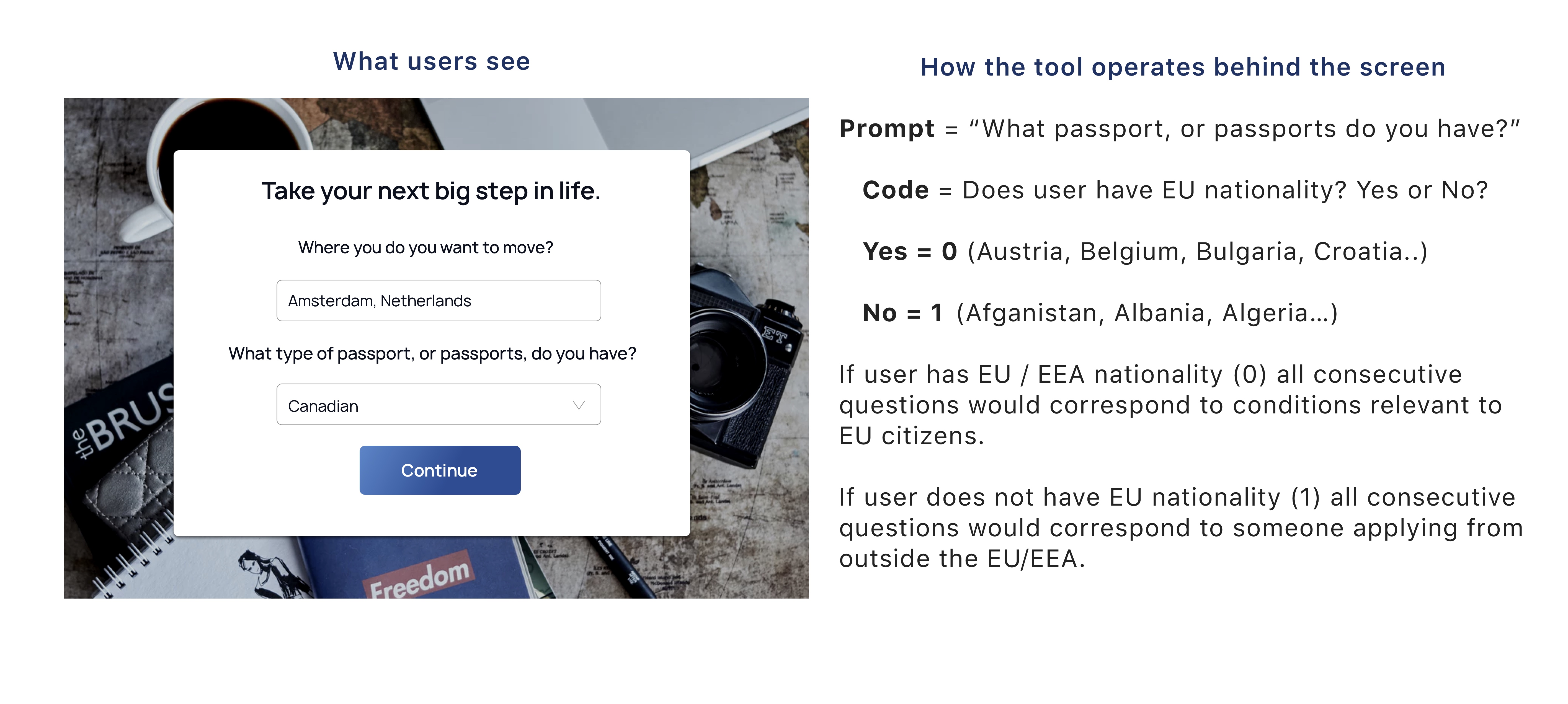
Develop & Ideate
I initially started by creating a flow diagram of the immigration process for applicants applying to live and work in the Netherlands. I based my design off the information provided by the IND website and related immgration application forms. With this content in hand, I had to translate answers on the IND website into questions that users could answer to create their "applicant profile."
I had to re-order, rewrite, and rephrase information provided by the IND as it was initially presented in an overwhelming manner (i.e., paragraphs of text answers, use of advanced policy-based language, etc.) Also keeping personalization in mind, I went beyond what the IND provided in resourcefulness by offering users alternative options and guidance as to how to become eligible to immigrate.
The flow diagram below is meant as a snapshot of the territory that immi would cover in terms of immigration advice. Thus it does not contain all possible scenarios and drawn-out complete flows.
Develop & Ideate
I initially started by creating a flow diagram of the immigration process for applicants applying to live and work in the Netherlands. I based my design off the information provided by the IND website and related immgration application forms. With this content in hand, I had to translate answers on the IND website into questions that users could answer to create their "applicant profile."
I had to re-order, rewrite, and rephrase information provided by the IND as it was initially presented in an overwhelming manner (i.e., paragraphs of text answers, use of advanced policy-based language, etc.) Also keeping personalization in mind, I went beyond what the IND provided in resourcefulness by offering users alternative options and guidance as to how to become eligible to immigrate.
The flow diagram below is meant as a snapshot of the territory that immi would cover in terms of immigration advice. Thus it does not contain all possible scenarios and drawn-out complete flows.
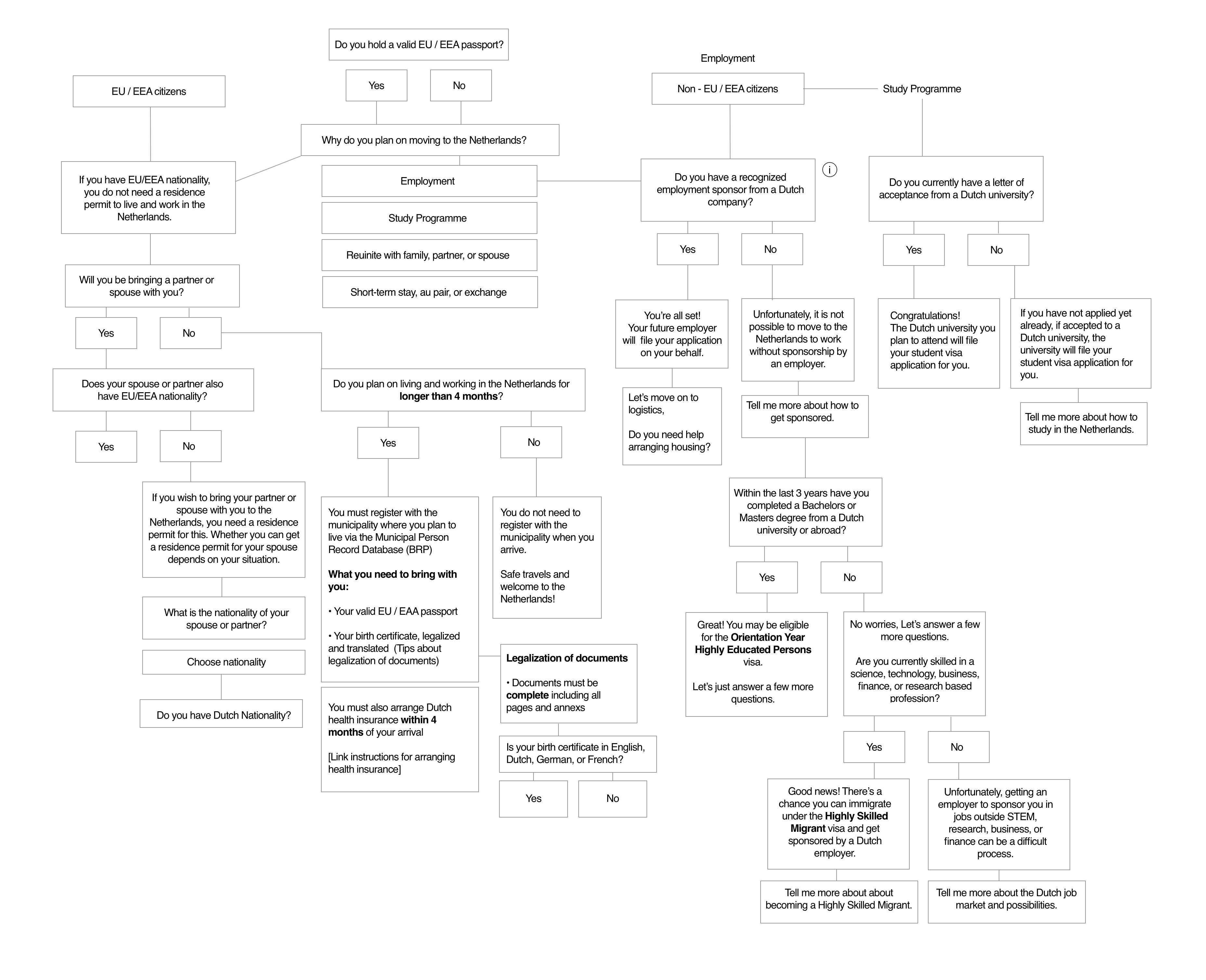
Prototype
In creating the prototype, I started out with a library of visual features from the site including colors and typography. The background image chosen for the landing page was intended to serve as a metaphor for openness and freedom to roam. Clearly immi is about immigration, but I did not want the feel of the site to signal themes related to immigration itself. The last thing I want users to feel is the stress similar to experiences at immigration and passport control checks.
Prototype
In creating the prototype, I started out with a library of visual features from the site including colors and typography. The background image chosen for the landing page was intended to serve as a metaphor for openness and freedom to roam. Clearly immi is about immigration, but I did not want the feel of the site to signal themes related to immigration itself. The last thing I want users to feel is the stress similar to experiences at immigration and passport control checks.
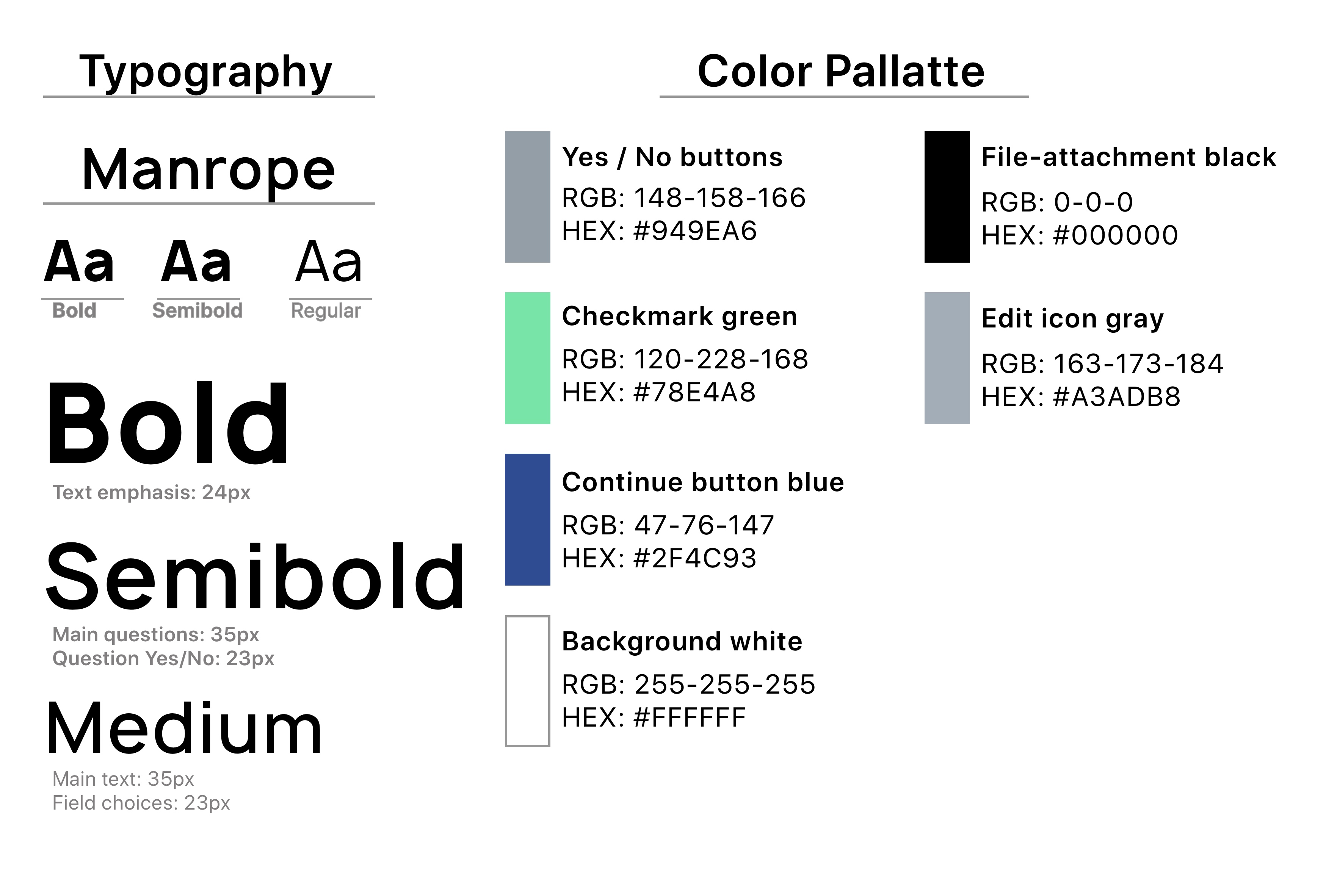
I moved straight into a hi-fi prototype as I had a good idea of how things would be laid out after working through the flow diagram. Also since the early renders of immi do not have extremely diverse page styles and elements, a collection of extensive wireframes was not necessary at this point of development.
Tools used: Sketch, Principle, Affinity Designer.
I moved straight into a hi-fi prototype as I had a good idea of how things would be laid out after working through the flow diagram. Also since the early renders of immi do not have extremely diverse page styles and elements, a collection of extensive wireframes was not necessary at this point of development.
Tools used: Sketch, Principle, Affinity Designer.
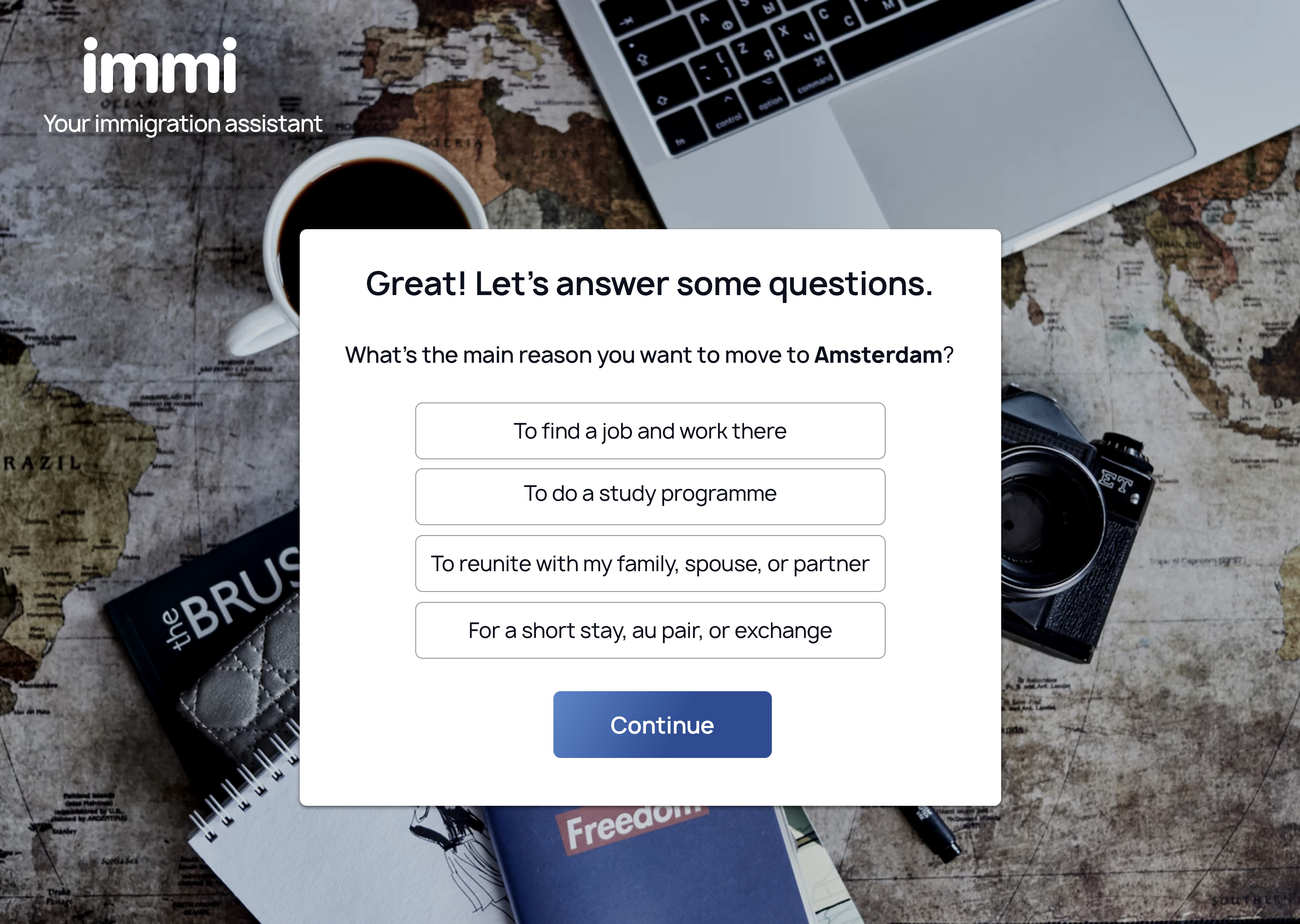
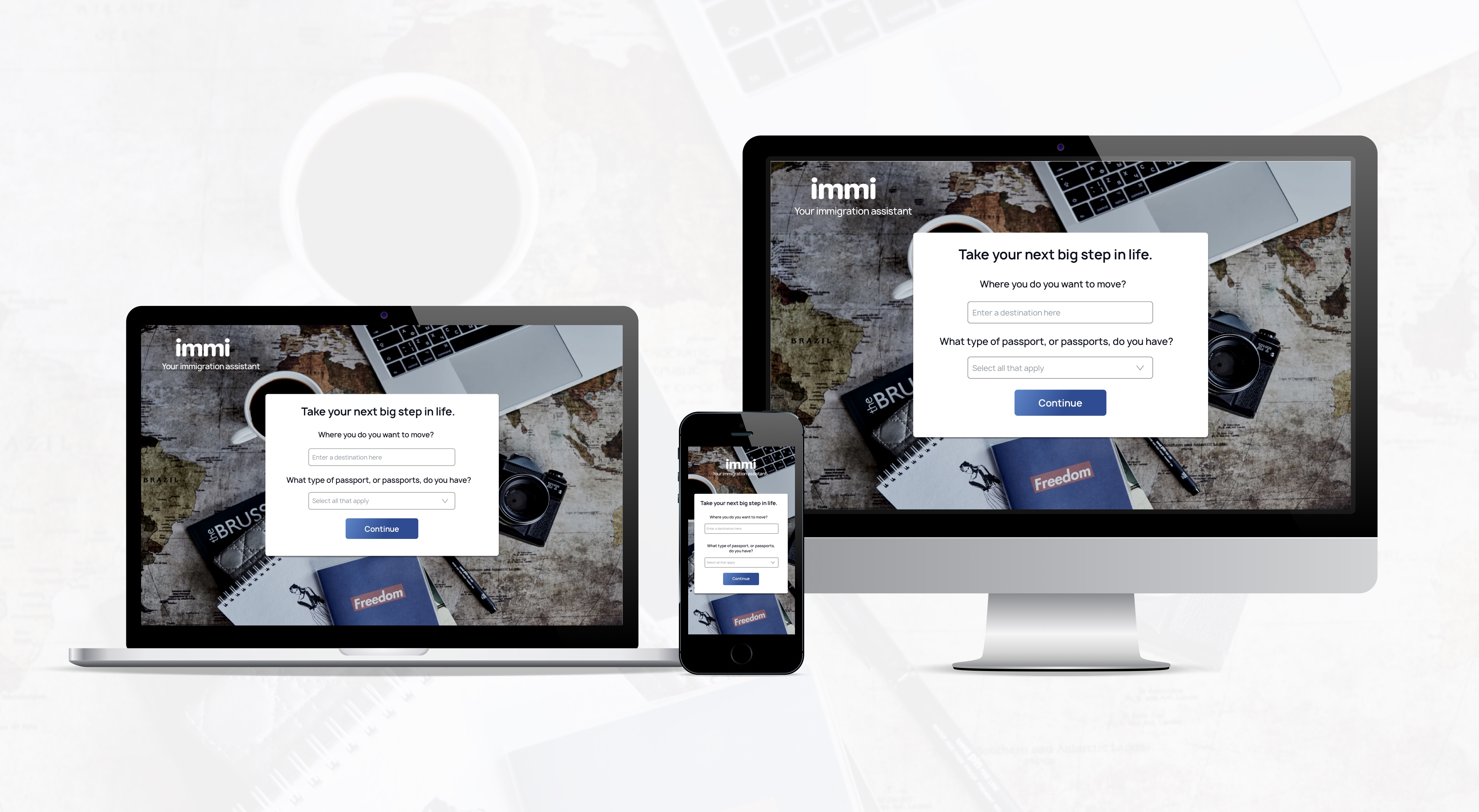
Review
After the process of completing the flow diagram prototype, I realized how extensive the scope of this project is in practice. Immi is essentially beyond just a personal project and could potentially be an entire startup based on the amount of time, research, and resources it demands. Not to forget, the necessity to keep information updated based on recently implemented laws and policies
In invisioning the future of immi, I believe this approach of designing user-friendly tools to navigate bureacratic government-based systems is a modern way of problem-solving. Dealing with politically based systems tends to adhere to traditionalism, which makes sense because it's low risk not to change things. But, at the same time, perpetually following rigid structures comes at the cost of innovation and improvement.
Future Considerations
For this project I was successfully able to design a responsive prototype from an original idea that, to my existing knowledge and research, had not been investigated before. Due to time constraints, this project was not carried out at its absolute fullest due to the fact its demands were beyond my individual capacity with regard to technical skills (programming) and research demands (time limitations). In ideal circumstances I would have liked to:
• Interview officials at the IND (Immigratie en Naturalisatie Dienst) about their insights and opinions regarding the application process
• Interview individuals who have gone through the application and immigration process (I myself being highly empathetic to this situation as I have personally gone through the process)
• Extensively complete the flow diagram whereby I could have a comprehensive skeleton wireframe of all possibilities
• Test a working interactive prototype (or prototypes) with groups of users to assess immi's functionality and potential effectiveness
Learnings
In working through this project, I was reaffirmed that the immigration process to come to the Netherlands was complicated, as are most immigration systems in the world. I personally have gone through the process myself as an international student and as a partner of a Dutch national. But, having explored and researched alternative pathways other people may take to come to the Netherlands, opened my eyes as to hidden and complex difficulties others (either wanting to immigrate or in the process of immigrating) deal with.
The biggest challenges I faced were locating information relevant to specific circumstances (i.e., From which country was someone applying) and matching that with their immigration options. Also, working through the dense text of forms to find anwers I needed to create the flow diagram and make it as personalized as possible was quite cumbersome.
The current IND website offers information, but it's not proactive in finding alternatives for users. For example, if someone does not meet certain requirements for a specific visa application, it does not direct them to other visa options that they may be eligible for. This being due to lack of personalization. In sum, these findings reaffirm that the IND website is a means to find information and apply, but does not necessarily emphasize a user-centered approach.
Review
After the process of completing the flow diagram prototype, I realized how extensive the scope of this project is in practice. Immi is essentially beyond just a personal project and could potentially be an entire startup based on the amount of time, research, and resources it demands. Not to forget, the necessity to keep information updated based on recently implemented laws and policies
In invisioning the future of immi, I believe this approach of designing user-friendly tools to navigate bureacratic government-based systems is a modern way of problem-solving. Dealing with politically based systems tends to adhere to traditionalism, which makes sense because it's low risk not to change things. But, at the same time, perpetually following rigid structures comes at the cost of innovation and improvement.
Future Considerations
For this project I was successfully able to design a responsive prototype from an original idea that, to my existing knowledge and research, had not been investigated before. Due to time constraints, this project was not carried out at its absolute fullest due to the fact its demands were beyond my individual capacity with regard to technical skills (programming) and research demands (time limitations). In ideal circumstances I would have liked to:
• Interview officials at the IND (Immigratie en Naturalisatie Dienst) about their insights and opinions regarding the application process
• Interview individuals who have gone through the application and immigration process (I myself being highly empathetic to this situation as I have personally gone through the process)
• Extensively complete the flow diagram whereby I could have a comprehensive skeleton wireframe of all possibilities
• Test a working interactive prototype (or prototypes) with groups of users to assess immi's functionality and potential effectiveness
Learnings
In working through this project, I was reaffirmed that the immigration process to come to the Netherlands was complicated, as are most immigration systems in the world.
I personally have gone through the process myself as an international student and as a partner of a Dutch national. But, having explored and researched alternative pathways other people may take to come to the Netherlands, opened my eyes as to hidden and complex difficulties others (either wanting to immigrate or in the process of immigrating) deal with.
The biggest challenges I faced were: Locating information relevant to specific circumstances (i.e., From which country was someone applying) and matching that with their immigration options. Also, working through the dense text of forms to find anwers I needed to create the flow diagram and make it as personalized as possible was quite cumbersome.
The current IND website offers information, but it is not proactive in finding alternatives for users. For example, if someone does not meet certain requirements for a specific visa application, it does not direct them to other visa options that they may be eligible for. This being due to lack of personalization.
In sum, these findings reaffirm that the IND website is a means to find information and apply, but does not necessarily emphasize a user-centered approach.